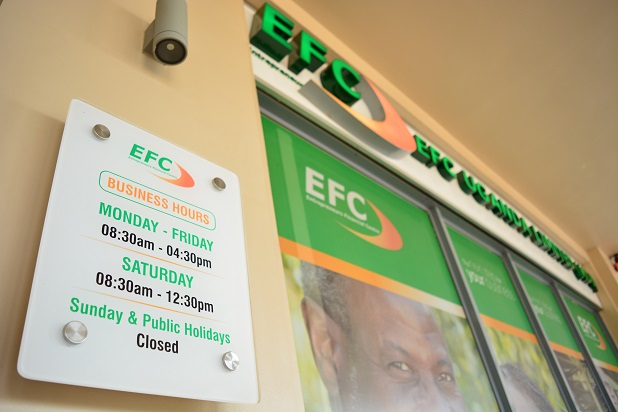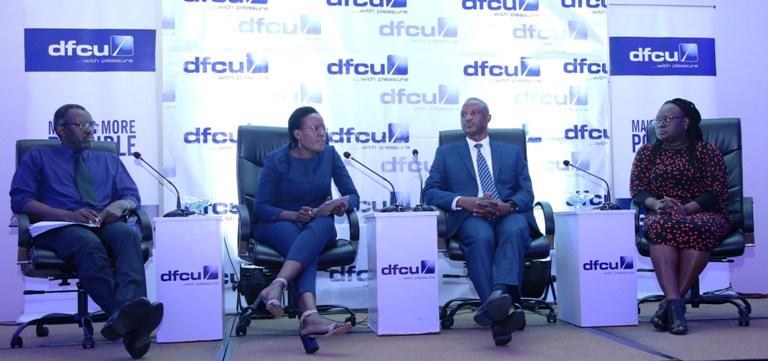EFC Uganda head office before it collapsed
EFC Uganda Limited, a Microfinance Deposit-Taking Institution, had run bankrupt at the time of its collapse, Business Focus reports. It’s understood that customers would go to withdraw money but return with nothing, necessitating the Bank of Uganda to take action of liquidating it and revoking its license.
The Deposit Protection Fund-Uganda has since revealed that it is going to pay Shs2bn out of the Shs52bn customers had in EFC Uganda Limited at the time of its liquidation by Bank of Uganda.
The revelation was made Yusuf Mukiibi, Director Finance during a press briefing held at the Fund’s headquarters in Kampala, where he explained that although the financial institution had deposits worth Shs52bn as at December 2023, the majority of the deposits were held by 20 depositors who accounted for Shs50bn in deposits, while the remaining Shs2Bn was held by the majority of depositors who accounted for 98% of the depositors.
“The bank had deposits of Shs52bn,” he said, adding that 23 depositors had over Shs10m while 20 customers owned most of the Shs50bn in deposit value.
“The rest of the depositors account for 2% which is the Shs2bn,” he said.
In the plan issued by Julia Clare Olima, Chief Executive Office, Deposit Protection Fund, unlike the previous years where it took depositors over six months to get their funds after closure of any financial institution, she promised that this time around, the Fund will ensure that provisions stated in Section 111(a) and section 111©5 of the Financial Institutions Act 2004 that stipulates that the Deposit Protection Fund is required to make payments of protected deposits to customers within a period of 90 days after closure of the financial institution are fulfilled.
“In the last closed banks, the depositors took long to get their money because at that time, we operated a highly manual system, but the DPF has come in place, we have a sophisticated payout system and that is why we are able to get this information from the banks and we are going to pay depositors within a record period of more than ten days from when the bank was closed. Previously, the Bank of Uganda would pay after 6months because of the circumstance that were there at that time,” said Olima.
According to the program released, depositors who have less Shs100,000 will be paid using mobile money and these account for 68%, while depositors to be paid through agent banking and have greater than Shs100,000 but less than Shs10M are 30% and depositors with balance above Shs10M who account for 2%.
The Fund managers further revealed that depositors who will be paid by the Agent Bank will be required to lodge in a claim for payment by filling out the Depositor Claim Form that shall be made available at the Agent Bank at no cost, and the depositors will be required to submit a set of documents including original national IDs for Ugandans, Passports for foreigners and company documents for institutions.
Mukkibi also revealed that EFC Uganda Limited Depositor analysis based on the information that the Fund received before the bank was closed, in December 2023.
He said that the depositors that have a balance of Shs100,000 and below are around 1,800 and depositors that had a balance between Shs100,000 to Shs10M were around 600, and depositors that had balances above Shs10M were roughly 40.
Olima also defended the decision by the Fund to only cover depositors with funds below Shs10M saying this covers the majority of the customers in Uganda.
She said, “When we look at the Shs10M, we are covering 98% of the depositors in the country according to the Deposit Protection Fund and also following the international principles of deposit insurance the Shs10M is adequate. The small and unsophisticated depositors are fully covered. The depositors that fall below Shs10M are 98% and we are going to pay them fully.”
She added that the limit is also intended to protect Uganda’s financial sector from moral hazards stating, “Deposit insurance limits can’t be raised too high because then you expose the sector to moral hazard where the depositors will put their money in any institution without thinking about the risks they are taking. Every decision you take is a risk, so you must think about the risk when you are putting money in a particular bank. That is why the principle is very clear, you must put a limit which covers the majority of your small and unsophisticated depositors and that is what we have done.”
Olima added that the 2% depositors that won’t be covered by the Fund are referred to as the knowledgeable depositors who should be monitoring the financial sector and who should be monitoring the performance of their banks and making good decisions.
She also added that the Shs10M limit is always subject to review because initially, the limit was Shs3M before it rose to Shs10M, but there are no guarantees that this will shoot up to a figure as high as Shs1Bn.
“The principles are very clear that every year, you review that limit to see if that limit is still adequate and very soon, we are starting the process of conducting research bench-marking with other deposit entities to see if this limit can be raised, but I can’t say that this limit will be raised to Shs1bn,” remarked Olima.
It should be recalled that on 19th January 2024, Bank of Uganda placed EFC Uganda Limited under liquidation, revoked its license, and ordered for the winding up of its affairs, with the Central Bank defending its decision on grounds that the continuation of EFC Uganda Limited’s activities is detrimental to the interests of its depositors due to the institution’s failure to resolve its significant under capitalization and poor corporate governance.
While announcing the closure of EFC Uganda Limited, Michael Atingi-Ego, the Deputy Governor, Bank of Uganda, said that Bank of Uganda and the Deposit Protection Fund of Uganda would inform depositors of the arrangements that will be put in place to enable them to access all of their deposits and also asked the borrowers to continue servicing their loans and also asked individuals possessing property of EFC Uganda Limited to deliver it to Bank of Uganda.
The closure of EFC comes at the time in 2023, Bank of Uganda alongside Ministry of Finance announced the increase of the minimum paid-up capital for commercial banks up to Shs120Bn, while that of credit institutions had its share capital increased to Shs20Bn and all players in the industry were required to fulfil these new requirements by 31st December 2022.
The Central Bank went further to reveal that the minimum capital thresholds will be further raised up to Shs150Bn for commercial banks and Shs25 billion for credit institutions by 30th June 2024, while the minimum capital requirement for microfinance deposit taking institutions, capital requirements were increased from Shs500m to Shs10bn. This is supposed to be fulfilled by June 2024.
However, since the pronouncement by Bank of Uganda, several financial institutions have been struggling to meet the new capital requirements, with may financial experts warning that if the new dates stick as per Bank of Uganda plans, there will be several mergers and acquisitions especially of smaller institutions.
A scrutiny of the annual financial reports on EFC website highlighted that as of December 2021, EFC owned assets of Shs112.8 billion, with shareholders’ equity of Shs12.982 billion.
The closure of EFC Uganda Limited came a few months after the institution in October 2023, announced the closure of five branches including; Kireka, Mukono, Nateete, Kalerwe and Nansana in a move the company said was “to help streamline business processes while leveraging on partnerships in the banking sector, but looking back at the move, many think it painted a grim picture of the financial woes the institution was grappling with before Bank of Uganda liquidated it.





